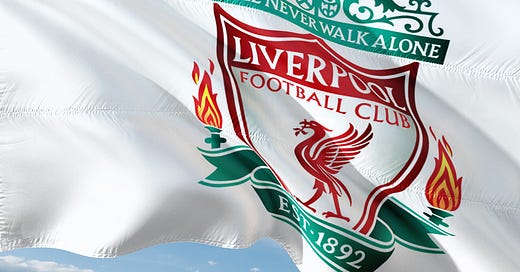Liverpool's 'The Red Way' Update
Innovations and important questions from an emissions report on a different scale
A week is a long time in club climate reports.
Liverpool have just published The Red Way: Overview and Highlights Report. It includes a section on carbon emissions (pgs.15-19) that I’ll focus on here. This follows quickly on the back of the club’s energy and carbon report ('SECR'), which was published in their annual accounts two weeks ago, and which I posted about last week.
In that post, I mentioned the SECR did not cover ‘scope 3’ emissions as they were not mandatory to report in annual accounts. In general, clubs have chosen not to report them, though that is starting to change (a good explainer of different scopes is here).
I also covered how important measuring and reporting these scope 3 emissions are to a full picture of clubs’ carbon footprints. A new report this week reinforces the importance of measuring these emissions.
All that said, I was not anticipating quite the difference that further scope 3 reporting could make!
A tale of two reports
In their SECR the club stated total 21/22 scope 1 and 2 emissions of 3,293 Tco2e. In The Red Way update, with scope 3 included, the club report total emissions of 140,198 Tco2e for the same period. To put this in further context, Manchester City’s most recent sustainability report for the same period, including scope 3 emissions, was 22,161 tCO2e emissions.
Erm, so what is going on here!?!
In short, there are three big-ticket scope 3 emission items included by the club in this new report that explain these differences - merchandise, supply chain, and fan travel.
Merch
Merchandise emissions reported here are 117,598 Tco2e (or 84% of a total 140,198 Tco2e).
I've not seen another club identify emissions associated with merchandise on anywhere near this scale. So, it’s a big and important reporting development. This is a high-level report and no further detail is provided. Further information on what is included within merchandise emissions and how it was worked out could be of great use to others.
Supply Chain
This is the second largest item in the report at 17,071 tCO2e. At over 12% of total reported emissions, it’s another very important source of reported emissions, and another area I’ve not seen other clubs report on, let alone at this scale. The club commits to “Engage with suppliers to align with LFC net zero targets”. The big difference that such work can make to reducing emissions is covered in this new report already mentioned above.
Fan Travel
Emissions on fan travel for 21/22 were 15,498 Tco2e. The only other Premier League clubs I have seen who also provide information on fan travel emissions are Wolves (at 11,064 tCO2e of a total of 13,041 tCO2e emissions) and Manchester City (at 7,648 tCO2e of a total of 22,161 tCO2e emissions).
Why are Liverpool's fan travel emissions higher? This could reflect different methodologies. And/or it could reflect Liverpool playing more games as they chased trophies to their latter stages on four fronts.
Overall Liverpool's emission figures for fan travel are not a great surprise even if showing some difference from these other clubs. Reporting in this area is new, complex and evolving.
It is also worth noting here that both merchandise and supply chain related emissions exceed those from fan travel. If that held across other clubs too it would seem to turn on its head a view that fan travel is the largest source of emissions in football.
Other items of note
The report notes that “only a small proportion of fans attend the events in person. The majority of fans consume the matches and content, either through their TV or live streaming … We therefore carried out an initial estimate … to start to calculate the carbon impact of this virtual fan impact”.
I’ve not seen emissions related to non-attending fans reported elsewhere, so again this is another innovation of note in the club’s approach. It’s not clear if these emissions have been counted in the figures here or if the plan is to do so in the future. They do not sit neatly in the list of categories presented.
Finally, on the figures, it is also worth highlighting that the club includes emissions from team flights - a subject that has drawn recent media attention to the club - at 755 Tco2e.
Questions, questions
This more inclusive and transparent approach to emissions reporting is clearly a positive development. It allows for greater clarity in prioritising the most important climate actions, even as it shows that the scale of the challenge for the football community could be bigger than previously thought. Alongside this, further details on the methodologies being used would be helpful to see. But it also points to some difficult questions more generally. These include:
How to ensure all clubs adopt a fully inclusive, transparent and proportionate approach to understanding and reporting their emissions? Would a similar approach to emissions reporting by governing bodies and for major tournaments impact on the figures reported, and if so how? What other organisations also have responsibilities or influence over the scope 3 emissions from football, and how to best to work with them? What actions does this tell us need to be prioritised?
I’d welcome your views on whether these are the right questions or any feedback, corrections or suggestions on any aspects of this post. If you have expertise in this area and would be interested in writing a further post on this too, or any related subject, drop us a line too! The more we can share understandings the better.
Here I have particularly focussed on the carbon emissions reported by the club. For a broader look at Liverpool’s progress on sustainability see this post from Global Sustainable Sport.
Fran James (he/him)
Football and Climate Change Newsletter
@fbandclimate
footballandclimatechange@gmail.com



